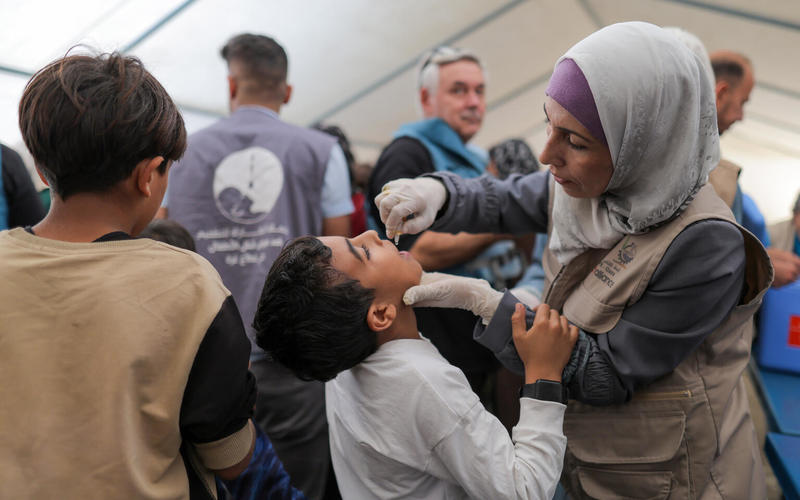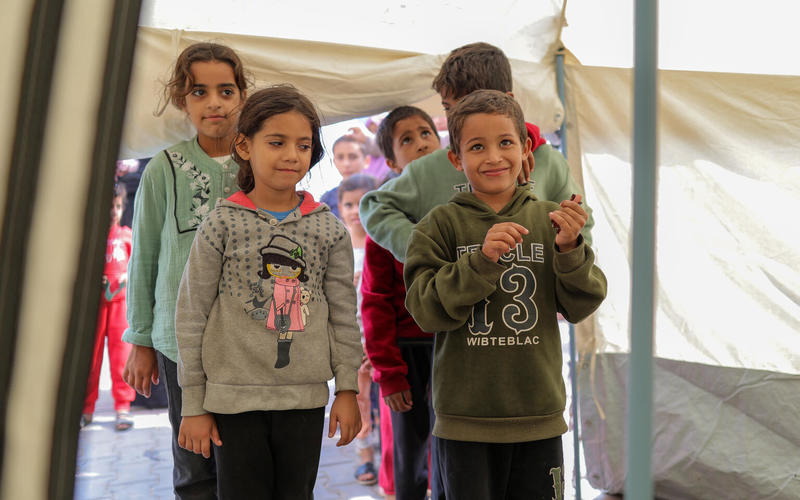
Despite active conflict in Gaza in 2024, a polio vaccination campaign achieved a 97% coverage among children under ten. The Palestine Ministry of Health, supported by UNICEF, WHO, UNRWA, and Global Polio Eradication Initiative partners, conducted two successful vaccination rounds in September and November. Over 1.6 million doses of nOPV2 vaccine were delivered, and Vitamin A supplementation reached 448,425 children (92.4% of eligible children). This remarkable achievement highlights the power of strong community engagement and international support in delivering essential healthcare amid conflict.
Photo: A health worker in Gaza administers the nOPV2 vaccine to a child amid the devastation of ongoing conflict, embodying resilience and hope in the fight against polio. UNICEF/2024/Media Clinic
The fight against polio has often been challenged by extreme conditions such as wars and natural disasters. The polio outbreak response in Gaza stands out as an unprecedented effort carried out in an active war zone with ongoing conflict. Since the war began in October 2023, more than 43,000 people have lost their lives, one-third of whom are children. Approximately 90% of Gaza's population has been displaced, many multiple times, with most now living in camps and shelters across the Gaza Strip. The majority of health facilities have been damaged, and routine immunization coverage—previously near 100% before the war—has significantly dropped. According to UNICEF, 60% of water and sanitation facilities have been destroyed or severely damaged, increasing the risk of communicable diseases due to overcrowding and poor hygiene—a situation that creates a high risk for polio transmission.

In July 2024, six environmental samples collected in Deir Al-Balah and Khan Younis, the most populated areas in Gaza, were confirmed as circulating vaccine-derived poliovirus type 2 (cVDPV2). In August 2024, a 10-month-old boy was paralyzed by the same strain of cVDPV2. After more than two decades of being polio-free, the Palestine Ministry of Health (MoH) declared a polio outbreak in Gaza.

Photo: Families displaced by conflict gather at a vaccination site in Gaza, demonstrating the critical role of community trust and collaboration in protecting children’s health.
Despite the immense challenges, the MoH in Gaza, with support from Global Polio Eradication Initiative (GPEI) partners—including UNICEF, WHO, and the United Nations Relief and Works Agency for Palestine Refugees in the Near East (UNRWA)—completed two rounds of outbreak response in September and November 2024.

Photo: A health worker provides life-saving polio immunization to a child in Gaza, showcasing the dedication of frontline workers in ensuring no child is missed, even during war.

Children smile after receiving their vaccines at a health center in Gaza, a testament to the success of the polio vaccination campaign amid extraordinary challenges.
UNICEF swiftly transported 1,605,000 doses of the novel oral polio vaccine type 2 (nOPV2) to Gaza within weeks. To strengthen Gaza’s cold chain system, which had lost 75% of its capacity due to the war, UNICEF provided two refrigerated trucks, 20 refrigerators, 10 freezers, 797 vaccine carriers, and 150 cold boxes. To ensure every eligible child was vaccinated with nOPV2, UNICEF collaborated with the MoH to train and deploy a network of more than 900 social mobilizers and town announcers in just a few weeks. Campaign messages were disseminated through SMS, WhatsApp, Telegram, and outdoor media such as banners and posters, reaching almost all caregivers in Gaza.
In the first round of the campaign, 559,161 children under ten were vaccinated. In the second round, held in November 2024, 556,774 children were vaccinated. Vitamin A supplementation was integrated into the second round, with 448,425 children receiving Vitamin A—representing 92.4% of the eligible children. Based on post-campaign monitoring, around 97% of eligible children were vaccinated in both rounds.

This remarkable achievement demonstrates that, even amid conflict, effective collaboration and strong community engagement can lead to successful health interventions. The high vaccination coverage in Gaza, despite the ongoing war, highlights the importance of local ownership, community trust, and international support in overcoming seemingly insurmountable challenges.
Written by Muhamad Ridwan Hasan, UNICEF MENARO Polio SBC Specialist
Edited by Daria Shubina, UNICEF NY HQ Polio SBC Knowledge Management Specialist

